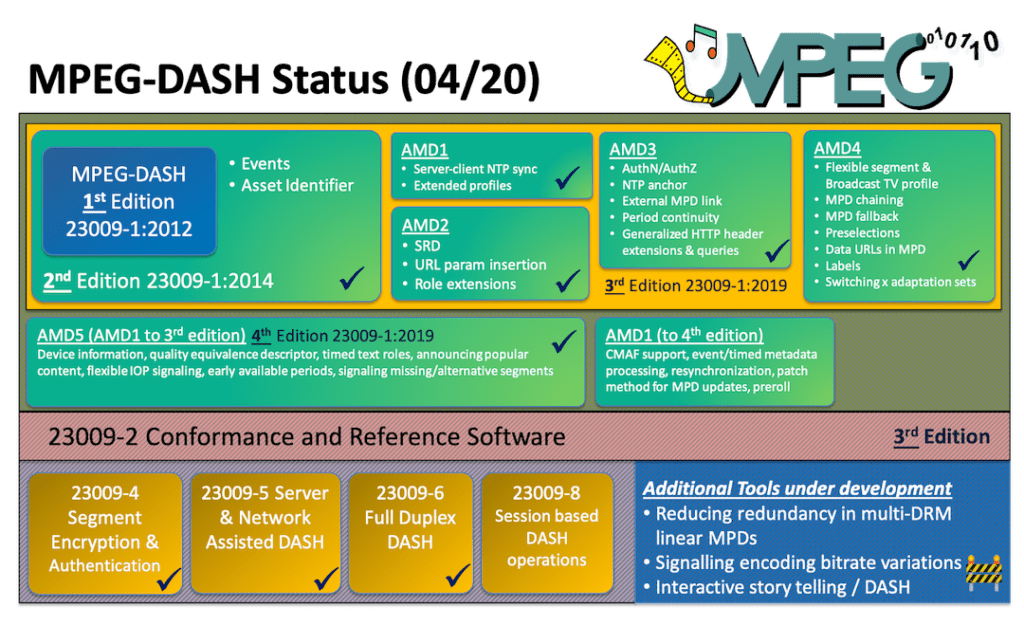Preface
“Shaping the Future of Video” is not just a catchy slogan that we like to throw around, rather it’s Bitmovin’s company vision. Not only do we keep a close eye on the industry trends, but we’re actively taking part in standardization activities to improve the quality of video technologies. I have been a member and attendant of the Moving Pictures Experts Group for 15+ years and have been documenting the progress since early 2010. The 130th MPEG meeting took place (virtually) on April 20th, 2020.
Virtual Experiences for All
Much like Bitmovin’s virtual NAB series, the 130th MPEG meeting was converted from a physical meeting to a fully online experience, the first in MPEG’s 30+ years of history. Approximately 600 experts attending from 19 time zones worked in tens of Zoom meeting sessions. Made possible by a combination of online activities (calendars, video chats) and collaborative coworking tools that involved MPEG experts in both online and offline sessions.
For example, input contributions had to be registered and uploaded ahead of the meeting to enable the efficient scheduling of two-hour meeting slots. The working meetings took place from early morning to late night to accommodate experts working across different time zones. These input contributions were then mapped to GitLab issues for offline discussions and the actual meeting slots were used primarily for organizing workloads, resolving conflicts, and making decisions (including approving output documents).
New formats, new challenges, newly completed tasks
Although the productivity of the online meetings did not match the level of production of our regular face-to-face meetings, the results of our work indicated that MPEG experts managed the challenge quite well, specifically by completing the following major tasks:
- MPEG ratifies MPEG-5 Essential Video Coding (EVC) Standard;
- MPEG issues the Final Draft International Standards for parts 1, 2, 4, and 5 of MPEG-G 2nd edition;
- MPEG expands the coverage of ISO Base Media File Format (ISOBMFF) family of standards;
- A new standard for large scale client-specific streaming with MPEG-DASH;
Other Important Activities at the 130th MPEG meeting: (i) the carriage of visual volumetric video-based coding data, (ii) Network-Based Media Processing (NBMP) function templates, (iii) the conversion from MPEG-21 contracts to smart contracts, (iv) deep neural network-based video coding, (v) Low Complexity Enhancement Video Coding (LCEVC) reaching DIS stage, and (vi) a new level of the MPEG-4 Audio ALS Simple Profile for high-resolution audio among others
The corresponding press release of the 130th MPEG meeting can be found here: https://mpeg.chiariglione.org/meetings/130. This report focused on video coding (EVC) and systems aspects (file format, DASH).
The MPEG-5 Essential Video Coding Standard is ratified at the 130th MPEG Meeting
At its 130th meeting, MPEG announced the completion of the new ISO/IEC 23094-1 standard which is referred to as MPEG-5 Essential Video Coding (EVC) and has been promoted to Final Draft International Standard (FDIS) status. There is a constant demand for more efficient video coding technologies (e.g., due to the increased usage of video on the internet), but coding efficiency is not the only factor determining the industry’s choice of video coding technology for products and services. The EVC standard offers improved compression efficiency compared to existing video coding standards and is based on the statements of all contributors to the standard who have committed to announcing their license terms for the MPEG-5 EVC standard no later than two years after the FDIS publication date.
The MPEG-5 EVC defines two important profiles, including “Baseline profile” and “Main profile”. The “Baseline Profile” contains only technologies that are older than 20 years or otherwise freely available for use in the standard. In addition, the “Main Profile” adds a small number of additional tools, each of which can be either disabled or switched to the corresponding baseline tool on an individual basis.
It will be interesting to see how EVC profiles (baseline and main) will find its path into products and services given the existing number of codecs already in use (e.g., AVC, HEVC, VP9, AV1) and those still under development but being close to ratification (e.g., VVC, LCEVC). We may end up with seven video coding formats within the next year that will need to be considered for future video products and services by content distributors. In other words, the multi-codec scenario I have envisioned some time ago is becoming a reality and raising some interesting challenges to be addressed in the future.
MPEG expands the Coverage of ISO Base Media File Format (ISOBMFF) Family of Standards
At the 130th MPEG meeting, the ISOBMFF family of standards was amended significantly with new tools and functionalities. The standards in question are as follows:
- ISO/IEC 14496-12: ISO Base Media File Format;
- ISO/IEC 14496-15: Carriage of network abstraction layer (NAL) unit structured video in the ISO base media file format;
- ISO/IEC 23008-12: Image File Format; and
- ISO /IEC 23001-16: Derived visual tracks in the ISO base media file format.
In particular, three new amendments to the ISOBMFF family have reached their final milestone, i.e., Final Draft Amendment (FDAM):
- Amendment 4 to ISO/IEC 14496-12 (ISO Base Media File Format) allows the use of a more compact version of metadata for movie fragments;
- Amendment 1 to ISO/IEC 14496-15 (Carriage of network abstraction layer (NAL) unit structured video in the ISO base media file format) adds support of HEVC slice segment data track and additional extractor types for HEVC such as track reference and track groups; and
- Amendment 2 to ISO/IEC 23008-12 (Image File Format) adds support for more advanced features related to the storage of short image sequences such as burst and bracketing shots.
At the same time, new amendments have reached their first milestone, i.e., Committee Draft Amendment (CDAM):
- Amendment 2 to ISO/IEC 14496-15 (Carriage of network abstraction layer (NAL) unit structured video in the ISO base media file format) extends its scope to newly developed video coding standards such as Essential Video Coding (EVC ) and Versatile Video Coding (VVC ); and
- the first edition of ISO/IEC 23001-16 (Derived visual tracks in the ISO base media file format) allows a new type of visual track whose content can be dynamically generated at the time of presentation by applying some operations to the content in other tracks, such as crossfading over two tracks.
Both are expected to reach their final milestone in mid-2021.
Finally, the final text for the ISO/IEC 14496-12 6th edition Final Draft International Standard (FDIS) is ready for the ballot after converting MP4RA to the Maintenance Agency. WG11 (MPEG) notes that Apple Inc. has been appointed as the Maintenance Agency and MPEG appreciates its valuable efforts for the many years while already acting as the official registration authority for the ISOBMFF family of standards, i.e., MP4RA (https://mp4ra.org/). The 6th edition of ISO/IEC 14496-12 is expected to be published by ISO by the end of this year.
A New Standard for Large Scale Client-specific Streaming with DASH
Historically, in ISO/IEC 23009 (Dynamic Adaptive Streaming over HTTP; DASH), every client has used the same Media Presentation Description (MPD) as it best serves the scalability of the service (e.g., for efficient cache efficiency in content delivery networks). However, there have been increasing requests from the industry to enable customized manifests for more personalized services. Consequently, MPEG has studied a solution to this problem without sacrificing scalability, and it has reached the first milestone of its standardization at the 130th MPEG meeting.
ISO/IEC 23009-8 adds a mechanism to the Media Presentation Description (MPD) to refer to another document, called Session-based Description (SBD), which allows per-session information. The DASH client can use this information (i.e., variables and their values) provided in the SBD to derive the URLs for HTTP GET requests. This standard is expected to reach its final milestone in mid-2021.
An overview of the current status of MPEG-DASH can be found in the figure below.

The next meeting will again be an online meeting and will take place at the end of June, beginning of July
Click here for more information about MPEG meetings and their developments
Check out the following links for other great reads!
A little lost about the formats and standards described above? Check out some other great educational content to learn more!
- [Blog Post] 129th MPEG Meeting Takeaways
- [Blog Post] 128th MPEG Meeting Takeaways
- Bitmovin’s Video Developer Network (No Sign-up Required!)
- [E-Book] Ultimate Guide to Container Formats




